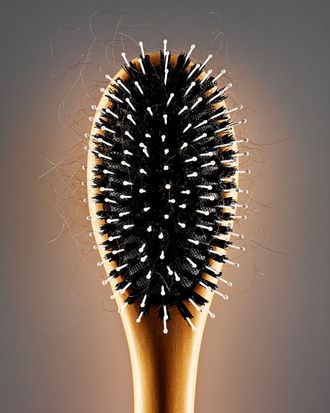
I started getting texts last year that started, “Hey, so I don’t know if this is just my imagination, but I think my hair is falling out?” around the middle of 2020. What started as a trickle, soon became discussion on TikTok. Alyssa Milano tweeted a video of her brushing her wet hair and pulling out little clumps, saying, “This is what COVID-19 does to your hair,” and it’s a frequent topic of discussion in Survivor Corps, a Facebook group for those who’ve recovered from COVID-19. In fact, hair shedding has become enough of an issue during the pandemic for the American Academy of Dermatology to put up a PSA about it.
Hair shedding is not a symptom of COVID, according to London-based dermatologist Dr. Sharon Belmo, who specializes in hair and scalp disorders. Instead, she said what people are most likely experiencing is a condition called telogen effluvium. While COVID seems to be triggering hair loss for some, Dr. Belmo explained it’s not anything unique to the virus that’s causing it. Instead, it is considered an aftereffect of a stressful event, like being sick with a nasty bug, or emotional stress, like losing a job or maybe just working a little bit too hard.
“You absolutely don’t have to catch COVID to suffer from this kind of hair loss and shedding,” said Dr. Belmo. “The turmoil of the last year or so has been enough to push people into all kinds of stress responses.”
Dr. Ranella Hirsch, a board-certified dermatologist, concurred, adding that it’s thought to be the stress of a fever in particular that triggers COVID-related hair shedding. “Often with COVID-19, patients develop a fever, and several months later, they often observe greater hair shedding,” explained Dr. Hirsch. Aside from fever, Dr. Hirsch said that general illness and stress are considered to be the main triggers for telogen effluvium — and during a pandemic, you may have had all three.
Hair loss could be due to a condition called telogen effluvium, which isn’t rapid, overnight mass shedding that leaves obvious bald patches, but more of a generalized shed, with perhaps a little more loss noticeable around the temples, said Ivy Carson, nurse practitioner at Parsley Health. “It has a very diffused pattern,” she explained. It’s normal to lose up to 50 to 150 hairs a day, so not all visible shedding is a sign of actual hair loss. As such, pinning down the cause can be hard. “For some women, maybe they notice that their scrunchie wraps around their ponytail four times now instead of three, or perhaps they have more baby hairs around their face than before,” added Carson.
Dr. Hirsch said that in her practice, telogen effluvium has become an “incredibly common complaint,” with numerous patients seeking advice and treatment. “Understandably, it’s very stressful for people,” she added.
There are many reasons that hair loss happens, from underlying hormone imbalances, genetics or maybe a deficiency in your diet. In this case, according to Carson, your body defaults to behaviors like this in times of stress because from a fight-or-flight perspective, you don’t need hair. “It shunts focus away from things like our digestion or growing hair and nails, because those are nonessential processes at that time when the body believes it’s in danger,” said Carson.
However, telogen effluvium has a unique peculiarity. “Generally speaking, telogen effluvium is diagnosed in retrospect,” confirmed Dr. Belmo. Because of the cyclical nature of hair growth, you may not notice any excessive shedding until maybe even six months after sickness or a stressful event. Aside from sickness and stress, other factors like an iron deficiency, hormonal changes linked to contraception or childbirth, thyroid problems, rapid weight loss, or drug side effects can also induce telogen effluvium, said Dr. Belmo.
As distressing as hair loss can be, however minor, both Dr. Belmo and Dr. Hirsch said telogen effluvium is not something to be panicked about, and that it usually resolves itself over time. “The shedding can go on for three to six months, but remember, it may not begin until six months after the stressful event,” said Dr. Belmo. While it’s tempting to obsessively track shedding and growth, Dr. Belmo said to resist the urge as much as possible. If you feel your hair loss has gone on for longer than six months or been especially dramatic, you should speak to your doctor to check for underlying conditions.
“The single most important thing for patients to know is that it’s almost always not permanent hair loss, just an acceleration of the growth cycle,” said Dr. Hirsch, also noting that minoxidil is FDA-approved for topical application to improve hair growth. There’s a range of minoxidil products on the market, so a conversation with your health-care provider about the best one for you is advisable. Dr. Belmo stressed the importance of getting back to overall health first, and letting hair growth come back in time.

